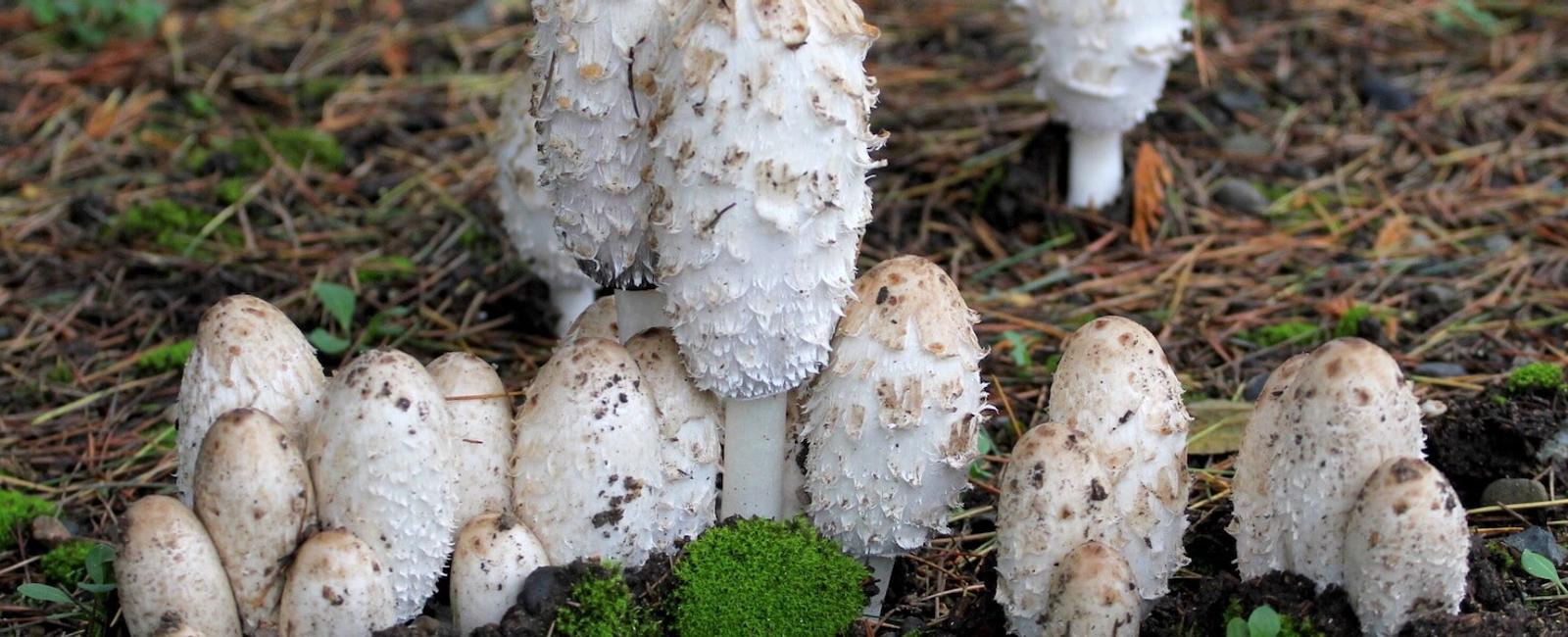

The world of edible mushrooms is exciting and filled with endless opportunities to explore. While it might be hard to believe that a mushroom capable of self-destruction is worth seeking out, we’re sure you’ll be eager for an outdoor adventure where you can meet this mushroom yourself.
In this guide, you’ll learn all about shaggy mane mushrooms. We’ll talk about what they look like and what makes them unique, where to find them, how to eat them, and much more. Let’s jump in!
What are shaggy mane mushrooms?
Known scientifically as Coprinus comatus (and sometimes Agaricus comatus), shaggy mane mushrooms are edible mushrooms that also go by the common names of shaggy mane, shaggy ink cap, lawyer’s wig, and Maotou-Guisan in Chinese.
These mushrooms are saprobic, meaning they obtain their nutrients from dead or dying organic matter.
Because shaggy mane mushrooms go through autodigestion or deliquescence as they mature, only young shaggy mane mushrooms are suitable for consumption. As these mushrooms grow, the gills and cap will start to liquify and ooze a black liquid or goo that looks like black ink, giving the impression that the mushrooms are dissolving into themselves and rendering them inedible (1).
When shaggy mane mushrooms grow, they form spiny structures in the soil that can tear the skin of nematodes and even seem to have anti-nematode toxins (2).
The taxonomy for shaggy mane mushrooms is as follows:
Kingdom: Fungi
Phylum: Basidiomycota
Class: Agaricomycetes
Order: Agaricales
Family: Agaricaceae
Genus: Coprinus
Species: C. comatus
Psst: A similar species, coprinopsis atramentaria or coprinus atramentarius, is sometimes called the common ink cap or inky cap mushroom. They can look similar to shaggy mane mushrooms when young, so be mindful of proper mushroom identification if you’re looking specifically for shaggy mane mushrooms.
What do shaggy mane mushrooms look like?
Shaggy mane mushrooms are named for the shaggy scales they have on their fruit bodies. They don’t have bell-shaped caps; they have a cylindrical cap with a rounded top when they’re young that flattens out as they mature. Once their top flattens, you can see their inky black gills peeking out from underneath.
A shaggy mane mushroom’s gills are white or cream colored, which transition to pinky blush. As the mushroom matures, its black spores will turn the rest of the gills black.
Its stipe is hollow and can range from 4 to 10 inches tall, with the widest part at the base (2).
Where do shaggy mane mushrooms grow?
Usually, you need to venture into the forest to find mushrooms. While that can be the case with shaggy mane mushrooms, you’re more likely to see them in more populated areas, such as lawns, meadows, barnyards, in wood chips for garden beds, and along roadsides.
Look for shaggy mane mushrooms in the late summer and fall. They grow in temperate regions (1) and favor cool, wet weather (3), so expect to see them in North America (they grow abundantly in the Pacific Northwest) and Europe.
Historical and traditional use of shaggy mane mushrooms

Our ancestors have used wild mushrooms for centuries to nourish and support the body. While we’ve been fortunate enough to have plenty of documentation on how ancient cultures have used some of these mushrooms, it isn’t as clear how shaggy mane mushrooms may have been used.
Without more concrete information, we can’t speak to the historical or traditional use of shaggy mane mushrooms. What we can share are some of its taxonomic origins.
Shaggy mane mushrooms were first identified as Agaricus comatus in 1780 by the Danish naturalist and scientific illustrator Otto Friedrich Müller. In 1797, this fungi received its current scientific name from German mycologist Christiaan Hendrik Persoon (4).
Health benefits of shaggy mane mushrooms
Shaggy mane mushrooms haven’t been as extensively studied as other mushrooms such as white button, reishi, turkey tail, or chaga mushrooms. Still, research has shown these mushrooms offer promising health benefits.
Researchers have discovered a protein called Y3 in shaggy mane mushrooms that can bind with proteins on the surface of specific leukemia cells. When this occurs, a chain reaction of enzyme activity causes 90% of leukemia cells to die.
Further studies continue to demonstrate the shaggy mane mushroom’s antitumor and antiviral properties, along with its ability to positively affect the immune system and the potential to lower blood sugar. However, this is limited to animal studies (5).
It’s important to note there have been cases where consuming alcohol after ingesting wild mushrooms can create the appearance of poisoning.
Coprine syndrome or coprine poisoning involves the compounds in the mushroom itself. Mushrooms in the genus of fungi Coprinellus or Coprinopsis (and in the family Psathyrellaceae) produce coprine. This compound causes a marked increase in ethanol sensitivity after ingestion. Symptoms can appear quickly and include palpitations, a metallic taste on the tongue, headache, vertigo, flush, vomiting, sweating, and collapse (6).
While there haven’t been any reports of widespread poisonings connected to shaggy mane mushrooms, it’s a reminder of how important it is to properly and accurately identify mushrooms.
Ethically wildcrafting shaggy mane mushrooms

The shaggy mane mushroom is considered an excellent mushroom to gather for beginners. But before you start exploring your local area, it’s essential to understand the difference between foraging and ethically wildcrafting mushrooms. Even though they may sound similar, they can have very different approaches.
Foraging is often used as a general term for gathering wild food sources like berries, plants, herbs, nuts, mushrooms, and more. Ethical wildcrafting is more specific and defined as harvesting local resources for medicinal needs. Another important distinction between the two is the focus wildcrafting places on the ecology of the local environment and the short- and long-term effects harvesting can have.
Learning the local area
Learning about the local area where you plan to harvest your shaggy mane mushrooms is always a good idea. Research whether or not there are any permits or special permissions required for where you plan to gather mushrooms.
You’ll also want to learn whether there are any threatened or endangered mushroom species to know about—and any potentially dangerous lookalikes or toxic mushrooms. Consult a field guide for guidance around identifying mushrooms. If in doubt, we strongly encourage you to find a professional or mushroom expert to help.
Mushroom anatomy and proper harvesting
A critical aspect of proper mushroom harvesting begins with understanding mushroom anatomy.
Most of the time, when we think we’re seeing the whole mushroom, we’re only seeing the fruiting body. But that’s just the tip of the iceberg. Beneath the surface lies a fascinating world where the other essential part of the mushroom, the mycelium, links mushrooms to the rest of their environment.
The mycelium is made up of tiny, delicate filaments called hyphae. This sophisticated network is how mushrooms communicate about their environment through electrical impulses, conveying information like environmental changes and whether any predators are nearby.
Bringing the right tools to harvest your shaggy mane mushrooms can make all the difference in how your harvest will impact the local environment. Whether you carefully slice a mushroom stem at its base or gently twist it free from the soil, do your best to keep the mycelium intact.
Ecosystem preservation
One of the most important things to remember when gathering your mushroom is to only take what you need. Overharvesting can throw off the delicate balance of an ecosystem, causing changes that could take years or even decades to recover from. We’re also not the only ones who enjoy feasting on mushrooms. Deer, birds, rodents, and critters all rely on mushrooms as a food source.
Gather only what you need, considering that you can grow many mushrooms at home. Before using your freshly harvested mushrooms, try making a spore print. They’re easy to make, help you identify mushrooms in the future, and allow you to experiment with home mushroom cultivation.
How can you enjoy shaggy mane mushrooms?

Shaggy mane mushrooms are a delightful mushroom to use in cooking, with some comparing its taste to young asparagus. It’s best to use your shaggy mane mushrooms as soon as possible after harvesting (within hours of harvest is ideal, although they can last up to two days after picking) since they have such a short shelf life. There’s no way to enjoy them once they turn into an inky mess, so act quickly. Here are a few of our favorite recipes to experiment with in the kitchen.
Sauteed shaggy mane mushrooms
It’s hard to beat an easy recipe for sauteed shaggy mane mushrooms. Prep time and cooking clocks in at 20 minutes, making this a quick side dish or snack. Simple ingredients like butter (olive would be delightful, too), salt, pepper, and parsley allow the delicate flavor of fresh shaggy mane mushrooms to take center stage. These aren’t fibrous mushrooms. Instead, they’re very tender, so making them shine in a meal doesn’t take much.
Shaggy mane mushroom soup
Mushrooms lend themselves well to comfort food like soups and stews, and this shaggy mane mushroom soup recipe delivers in under an hour. Simple ingredients bring out the shaggy mane’s flavor, and coconut cream adds a soul-satisfying richness that’s hard to beat.
Cozy mushroom risotto
While you might think mushroom risotto is perfect for mushrooms like morels, we invite you to experiment with shaggy mane mushroom risotto. Garlic, white wine, parmesan, fresh thyme, and freshly harvested shaggy mane mushrooms combine to make a rich and flavorful meal you won’t soon forget.
Shaggy mane mushrooms: An unexpected culinary delight
Shaggy manes are unassuming little mushrooms that are a delightful surprise, yielding a delicate flavor and promising health benefits. While you must cook with shaggy mane mushrooms shortly after gathering, these are edible mushrooms you’ll want to enjoy again and again.
Be sure to keep up with all things mushroom on shroomer, where you’ll learn more about identification and all the latest breakthroughs and discoveries on functional and psychedelic mushrooms.
References
- Stamets, Paul. Growing Gourmet and Medicinal Mushrooms. Ten Speed Press, 2011. https://fungi.com/collections/books-by-paul-stamets/products/growing-gourmet-and-medicinal-mushrooms
- “Coprinus Comatus – Mushrooms Up! Edible and Poisonous Species of Coastal BC and the Pacific Northwest.” n.d. https://explore.beatymuseum.ubc.ca/mushroomsup/C_comatus.html
- “Vancouver Island Mushrooms - Shaggy Mane Mushrooms.” n.d. https://www.westcoastforager.com/articles/shaggy-mane-mushrooms
- “Coprinus Comatus.” n.d. Academic Accelerator. Accessed September 28, 2023. https://academic-accelerator.com/encyclopedia/coprinus-comatus
- “Coprinus Mushroom Benefits? | Hair, Skin & Nails | Andrew Weil, M.D.” 2019. DrWeil.Com. July 7, 2019. https://www.drweil.com/health-wellness/body-mind-spirit/hair-skin-nails/coprinus-mushroom-benefits/
- “Coprine.” n.d. Science Direct. https://www.sciencedirect.com/topics/pharmacology-toxicology-and-pharmaceutical-science/coprine#:


